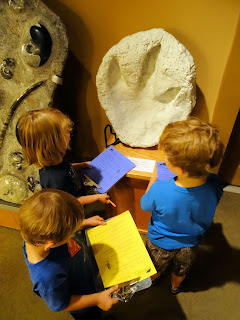It was
the Bob Campbell Geology Museum that brought us out to Clemson this time (our
previous visit having been the 9th annual Upstate Farm Tour and the
Clemson University Student Organic Farm). It was a hot and sunny day, the type
of weather perfect for the succulents and plants in the Chihuahuan Garden. This
high-altitude desert collection contains about 300 species of cactus and other
species from Sonoran and Chihuahuan deserts. Accustomed to the cold
temperatures of winters in these deserts, the cacti can survive the winters
here in the Upstate.
The
garden in the courtyard directly in front of the geology museum is the Lawrence
A. Sutherland Family Garden. The Sutherland garden has a diverse planting of
trees, shrubs and perennials, in addition to rocks and mineral specimens,
mining artifacts and mill stones. Try explaining to a group of 3-6 year olds
that the old mining apparatus is not playground equipment, that they cannot add
to their rock collection via the crystals and ores found trailside, and that
rocks should not be flipped in search of wildlife. Luckily a sand-sifting station
(as might be found on an excavation) is located at the door of the museum to
busy little hands, and soon we had regrouped and were ready to enter the
museum.
What started
as a small collection managed by Mrs. Betty Newton of the geology department at
Clemson University grew over the years, and thanks to Mr. Robert S.
"Bob" Campbell and his wife Betsy, the museum was built in 1998 to
house all the gems, minerals, fossils and like that had accumulated over the
years. Home to a remarkable collection
of over 10,000 rocks, minerals, fossils, lapidary objects (carvings,
gemstones), and artifacts (mining equipment, Native American tools), I could
have easily spent hours there; however with the three boys in tow our visit was
a bit briefer.
 |
| Photo credit to Heidi Johnson |
Upon
entering we were greeted by the life-sized skeletal replica of the ferocious
saber-toothed cat Smilodon that once
roamed this state, affectionately nicknamed Clemson’s “oldest tiger.” However
the group rather quickly dispersed in all directions to complete the scavenger
hunt that had them exploring the samples on various touch tables and searching
for certain specimens within the museum.
The
Fluorescent Mineral Room has one of the region's largest displays of
fluorescent minerals. We stepped inside and closed the door, to the delight of
kids and adults alike!
The
gemstone collection is impressive, with over 2000 sparkling gemstones to admire
and covet. Geodes of every size and color rounded out the display, with a giant
amethyst geode weighing 450 pounds impressing even the boys.
The
boys each received a small mineral to take home as a souvenir for completing
the scavenger hunt, and we descended back through the cactus garden to the
picnic tables below for a well-earned snack. The Museum is located within the
Clemson Botanical Gardens, and as we had already come all this way we couldn’t
pass up the opportunity for more exploration. Heading back towards the entrance
we parked once more, passing a few hours traversing the gardens; however, with
close to 300 acres to explore, we really haven’t even scraped the surface yet of
this superb botanical, historical and educational resource right here in the
Upstate – we will be back.
 |
| Photo credit to Heidi Johnson |





Fluorescent minerals?! That is so cool!
ReplyDelete